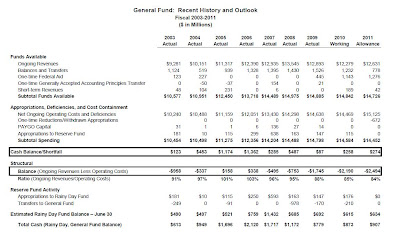Today, Maryland Democrats are celebrating the reelection of Governor Martin O’Malley, U.S. Senator Barbara Mikulski and their holding onto both chambers of the General Assembly. But the reality of governance will soon set in. Why?
Because the Republicans have won control of the U.S. House of Representatives, and that means federal stimulus aid for the state government has almost certainly dried up.
Maryland’s state government has been subsidized by federal stimulus money under ARRA (the American Recovery and Reinvestment Act of 2009) for three fiscal years: 2009, 2010 and 2011. According to the state’s latest Spending Affordability Committee report, the state government has received $4.4 billion of stimulus funding over the last three fiscal years. The largest subsidies have been directed to Medicaid ($1.6 billion), education ($1.1 billion) and infrastructure ($781 million).
The stimulus funds have been invaluable for closing Maryland’s general fund deficits. In FY 2009, 2010 and 2011, the state racked up $6.4 billion in structural general fund deficits. It has used $2.9 billion of federal stimulus money to help close those deficits. That means federal money has been used to plug almost half of Maryland’s budget gaps.
With the election of a Republican U.S. Congress, that money is gone. And Maryland faces a general fund deficit in FY 2012 that could be as high as $1.6 billion. That leaves a number of unappetizing options to deal with it.
Budget Cuts
In FY 2011, 41% of all state general fund spending was sent as aid to local governments. By spending category (which overlaps local aid), 50% of the general fund goes to education, 24% goes to health care and 9% goes to public safety. Those three items combined account for 84% of the general fund in FY 2011. It’s probably impossible to have meaningful long-term spending cuts without touching one or more of these areas.
Teacher Pensions
In the 2010 session, the Senate passed a plan to phase in a partial handoff of teacher pension obligations to the counties. The plan would have saved the state no money in FY 2011, $63 million in FY 2012, $194 million in FY 2013 and more than $300 million annually in the out years. Those out year revenues are significant, but the state’s budget problems may necessitate collection of them earlier. So the General Assembly could well choose to accelerate the phase-in and make the counties assume a greater share of the cost than in the Senate’s plan.
Diversion of Transportation Revenues
The Transportation Trust Fund (TTF) claims over $800 million a year in state funding. The TTF’s revenues include vehicle titling fees (20%), gas taxes (19%), registration fees (15%), operating revenues (10%), sales taxes (6%), corporate income taxes (4%) and more. All are ripe for diversion to the general fund. The General Assembly has already seized transportation money due to the counties so state transportation money could be next. That would be a disaster for the state’s infrastructure, but if transportation advocates are pitted against education advocates, who do you think will win?
Tax Hikes
The three most discussed taxes are an extension of the millionaire tax (which was supposed to last for three years), the imposition of combined reporting to capture more corporate income taxes and an extension of the sales tax to services. The first two options will be resisted by the business community and both have very uncertain revenue generating capabilities. The last time the state tried to extend the sales tax to services, the result was the much-hated computer tax (which was repealed in 2008).
Casting a long shadow over the taxation debate is the state’s competitive position with its neighbors – especially Virginia. The Tax Foundation’s FY 2011 tax competitiveness report ranks Delaware #8, Virginia #12, Pennsylvania #26, West Virginia #37 and Maryland #44 of the fifty states. Here is how Maryland compares to Virginia on a few tax measures.
Corporate Income Tax
Maryland: 8.25%
Virginia: 6.00%
Top Income Tax Rate
Maryland: 6.25% (at $1 million income)
Virginia: 5.75% (at $17,000 income)
Sales Tax
Maryland: 6%
Virginia: 5%
Maximum Unemployment Insurance Tax Rate
Maryland: 13.5%
Virginia: 6.2%
At least the state will not have to pay for Bob Ehrlich’s proposed $700 million sales tax cut.
Now what were we saying about celebrating?
Wednesday, November 03, 2010
Now Comes the Hard Part
Posted by
Adam Pagnucco
at
2:00 PM
![]()
![]()
Labels: Adam Pagnucco, budget, State Aid, taxes, Teacher Pensions, transportation


